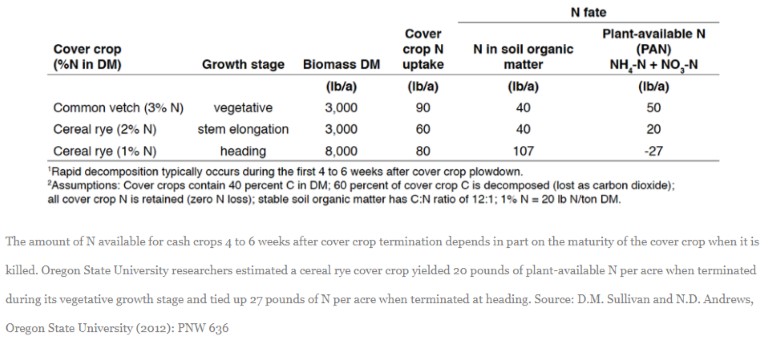Implementing soil health practices requires us to plan and make management decisions beyond the normal rotations in Minnesota. Herbicides, pests and disease, and nutrient management are some of the factors to consider when changing your management. Nitrogen is necessary for crop growth, too much and we’re wasting our money, not enough and yields reduce, what about timing of availability? The 4R’s were developed for good reasoning, applying nutrients at the right time, right place, right source, and right rate to maximize yield and profitability while reducing leaching and overspending on inputs. Throw cover crops in the management and the equation needs to account for more factors. Legumes can be used to fix nitrogen helping to reduce the amount of additional nitrogen to be supplemented. Some cover crops root down deep and pull nutrients back up into the rooting zone bringing nutrients that were out of the crop’s reach. Some cover crops are heavy nitrogen feeders, take up a lot in their biomass and release it as it decomposes.
Another twist in the mix is increasing your organic matter and soil biology which makes nutrients more available, a 1% increase in organic matter equals at least 20lbs of nitrogen, 5.5lbs of phosphorous, and 2.5lbs of sulfur per year that is plant available. Also, when you increase your soil biology, the processes of converting nutrients to plant available forms increases due to more action happening under our feet.
University of Oregon completed a study of nitrogen uptake and release with common vetch and cereal rye:

A study completed at the Agricultural Research Center in Illinois found “Overall, hairy vetch plants released almost three times as much nitrogen compared to cereal rye plants. More than 70% of the total nitrogen released by hairy vetch occurred within the first two weeks after termination. In contrast, nitrogen release from cereal rye occurred later, with almost no net nitrogen release in the first four weeks after termination.” This information is important for timing release for your crop needs. “Hairy vetch releases almost all available nitrogen in the first four weeks after it’s terminated,” says Rachel Cook. That’s before the major time of nitrogen uptake by corn, which is around week eight after planting. “So, terminating hairy vetch too early could cause losses of nitrogen before the corn crop can get to it.” https://www.sciencedaily.com/releases/2018/02/180214093839.htm
Utilizing mixes can be a method of mitigating fast decomposition and availability of nitrogen. The ideal C:N ratio to have nitrogen available is 24:1 or lower, but lower values are better for the time the cash crop needs ample nitrogen. Studies where 2:1 clays are present show a different release rate of nitrogen so location and climate are key, the Red River Valley is within that area.
Thinking of our soils as a savings account for nutrients, needing to build it so over time we have a bank of available nutrients instead of an ATM and getting nitrogen back immediately will help us better manage for nutrients. Farmers across Minnesota have been figuring out the 4R’s while implementing soil health practices, I believe it’s time to complete sampling here at home to determine Minnesota numbers.
